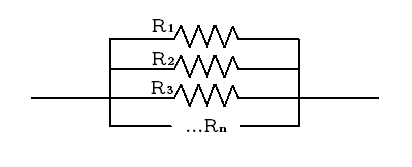There are $n$ resistors connected in a parallel combination given below.

$$\frac{1}{R_{ev}}=\frac{1}{R_{1}}+\frac{1}{R_{2}}+\frac{1}{R_{3}}+\frac{1}{R_{4}}+\frac{1}{R_{5}}.......\frac{1}{R_{n}}$$
Foundation Science - Physics (class 10) by H.C. Verma states (Pg. 68)
For two resistances $R_{1}$ and $R_{2}$ connected in parallel,
$$\frac{1}{R_{ev}}=\frac{1}{R_{1}}+\frac{1}{R_{2}}=\frac{R_{1}+R_{2}}{R_{1}R_{2}}$$ $$R_{ev}=\frac{R_{1}R_{2}}{R_{1}+R_{2}}$$
We see that the equivalent resistance in a parallel combination is less than each of the resistances.
I observe this every time I do an experiment on parallel resistors or solve a parallel combination problem. How can we prove $R_{ev}<R_{1},R_{2},R_{3},...R_{n}$ or that $R_{ev}$ is less than the Resistor $R_{min}$, which has the least resistance of all the individual resistors?
